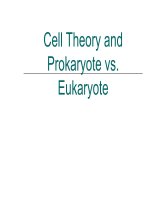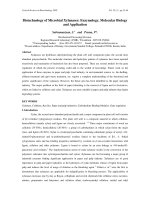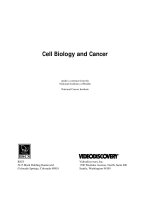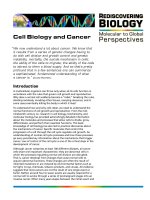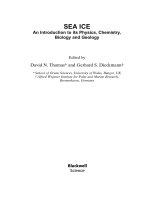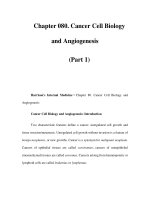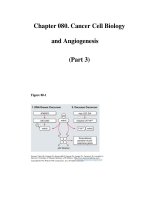Cell biology and plamid
Bạn đang xem bản rút gọn của tài liệu. Xem và tải ngay bản đầy đủ của tài liệu tại đây (6.26 MB, 35 trang )
1
Cell Biology
A cell is chemical system that is able to maintain its structure
and reproduce. Cells are the fundamental unit of life. All
living things are cells or composed of cells.
2
The interior contents of cells is the cytoplasm. The cytoplasm is
isolated from the surrounding environment by the ______ ______ .
There are two fundamentally different forms of cells.
__________ cells -
relatively simple cells - lack
nuclear membrane and many
organelles - bacteria and
their relatives are all
prokaryotic
___________ cells - more
complex cells - have a
nucleus and many organelles
- all cells of plants, animals,
fungi, and protists
3
Most cells are small
Prokaryotic: 1-10 µm
Eukaryotic: 10 - 100 µm
(1 µm = .001 mm)
Cells and
organelles
4
Organelles, Macromolecules, & Atoms
5
As cell size
increases the
volume increases
much faster than
the surface area.
Cells obtain
nutrients, gain
information and
rid waste through
their plasma
membrane.
As cell size increases, a cell’s ability to exchange with its
environment becomes limited by the amount of membrane area that
is available for exchange.
Why are cells small?
6
Robert Hooke - 1665 -
using an early microscope
viewed cork and saw many
repeating box-like
structures and called them
“cells.”
What he saw were spaces
surrounded by walls that
once contained living
cells.
Since Hooke’s first observations
what is known about cells has
increased greatly.
7
Cell Theory
• Cells are the fundamental unit of life - nothing less than a cell is
alive.
• All organisms are constructed of and by cells.
• All cells arise from preexisting cells. Cells contain the
information necessary for their own reproduction. No new
cells are originating spontaneously on earth today.
• Cells are the functional units of life. All biochemical processes
are carried out by cells.
• Groups of cells can be organized and function as multicellular
organisms
• Cells of multicellular organisms can become specialized in form
and function to carry out subprocesses of the multicellular
organism.
8
Prokaryotic cell structure
small, with a plasma membrane surrounded by a rigid cell wall -
in many the cell wall is made of _____________ - a carbohydrate
cross-linked with polypeptides
cell wall may be covered with a capsule made of polysaccharides
few or no membrane
enclosed spaces
within the cytoplasm
no nucleus - DNA is
in a region called the
nucleoid
DNA is circular and
naked (has no protein
associated with it)
9
Bacteria often have flagella with a single protein core (flagellin)
that they can use to move in a rotary corkscrew like fashion
The rotary motor
of prokaryotic
flagella is
powered by
proton flow
through the cell
membrane.
Rotating
structures are
rare in nature.
10
Membrane enclosed spaces allow cell functions to be
compartmentalized and isolated from other functions.
Prokaryotes lack membrane enclosed spaces in their cytoplasm.
Some prokaryotes are
photosynthetic. The
biochemical machinery
for trapping light energy
is contained within a
highly folded plasma
membrane.
11
Eukaryotic cell structure
larger, with a typical plasma membrane - some with a cell wall
Many _________________________ and other interior spaces
enclosed by membranes:
Nucleus, Endoplasmic reticulum, Golgi apparatus,
Mitochondria, Chloroplasts, Lysosomes,Vacuoles, Vesicles
Cytoplasm with a cytoskeleton - protein tubules and fibers
cell wall found in plants (cellulose), fungi (chitin), some protists
12
Cellular Organelles
Nucleus - the largest and most obvious membrane bound
compartment - controls cell activities
contains the nucleolus - a darkened region where ribosomal RNA is
synthesized
contains chromosomes - consist of DNA wrapped around proteins
13
Nucleus is surrounded by the nuclear envelope - a double
membrane
Nuclear membrane has nuclear pores that control entry and exit of
materials
14
Chromosome - “colored body”
consists of both DNA and protein - seen as chromosomes when
highly condensed in preparation for cell division
At other times the DNA and
protein are threadlike and
called __________.
The most common proteins
are histones. DNA is coiled
around histones in a regular
pattern that produces
structures called
nucleosomes.
15
Endoplasmic reticulum (ER) - a web-like series of membranes
within the cytoplasm in the form of flattened sheets, sacs, tubes,
creates many membrane enclosed spaces - spreads throughout
the cytoplasm - has connections with the outer membrane of the
nucleus and the plasma membrane
interior space is called the ______
Functions:
-circulation and
transport
-storage of proteins
and minerals
-synthesis of lipids,
carbohydrates, and
proteins
-A large surface area
for enzyme action.
16
Two types of ER - rough and smooth
rough ER - studded with ribosomes
site of synthesis of many proteins
all ribosomes on rER are actively
involved in protein synthesis -
smooth ER - site for synthesis of
steroids and other lipids
Ca
++
storage in muscles
detoxification of drugs, toxins,
alcohol (especially in liver)
The highly convoluted surface
provides a large surface area for
enzymatic activities. Many enzymes
are imbedded in the membranes.
17
Ribosomes - protein
synthetic machinery
• two subunits - large and
small - each made of
protein and ribosomal
RNA (rRNA)
• subunits associate when
they are synthesizing
proteins
• protein synthesis occurs
on ribosomes that are
free-floating in the
cytoplasm and on
ribosomes attached to ER
• rRNA is synthesized in
the nucleolus
18
Golgi Apparatus -
a collection of membranes associated with the ER
composed of flatten sacs called _________
concentrates and packages proteins synthesized on the ER
The Golgi is functionally associated with the ER.
19
Proteins synthesized on
the ER are concentrated
internally and transport
vesicles are budded off
Transport vesicles fuse
with the Golgi, dump
their contents into the
Golgi
Golgi packages proteins
in vesicles so that they
may be excreted from
the cell, or used within
the cell.
Secretory vesicles - used for excretion -
leave the Golgi and move to plasma
membrane where they fuse and dump
their contents outside - seen in many
glands
20
The Golgi Apparatus also forms lysosomes
Lysosomes - vesicles filled with digestive enzymes - used for
intracellular digestion
Particles can be
taken into cell
by phagocytosis
and vesicle fused
with lysosome
The components
of organelles can
be recycled after
digestion by
lysosomes
21
Microbodies: Peroxisomes and Glyoxisomes
vesicles that form through growth and division within the
cytoplasm
Glyoxisomes are found in plants - contain enzymes that convert
fats into carbohydrates
Peroxisomes - used for
removing reactive
compounds from the
cytoplasm - create H
2
O
2
as
a byproduct and degrade it
with the enzyme catalase
22
Mitochondria - cellular powerhouses - the site of much of the
energy harvest by cells
have double membrane structure
inner membrane folded into inward projections
called cristae
two spaces within the mitochondrion -
the matrix and the intermembrane space
23
Mitochondria -
• The site of oxygen consumption within cells
• Have their own DNA that is similar to prokaryotic DNA
• Have their own ribosomes that are similar in construction to
prokaryotic ribosomes
• Synthesize many, but not all, of their own proteins
• Mitochondria replicate by binary fission - similar to prokaryotic
cell division
24
Chloroplasts - sites of photosynthesis - in nearly all plants and
some protists
trap light energy and convert it into chemical energy
have double membrane structure - inner space is the stroma
Within the stroma
have a series of
stacks of flattened
membrane
structures called
thylakoids - the
stacks are called
grana
The light energy trapping molecules of
photosynthesis are found in the membranes of
the thylakoids.
25
Chloroplasts
have their own DNA, similar to prokaryotic DNA
Can synthesize many of their own proteins using prokaryote-like
ribosomes
Synthesize many, but not all, of their own proteins
Replicate through division similar to prokaryotic cell division
Chloroplasts can take on other functions
____________ synthesize and store starch in roots and tubers
____________ have pigments and give fruits ripened color

